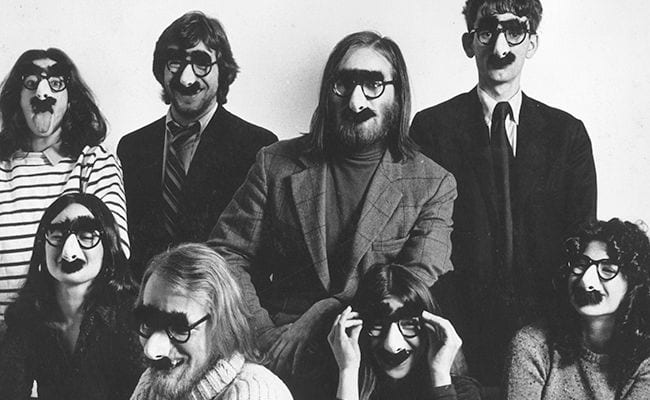
People who only know National Lampoon as that odd possessive sitting atop posters for Animal House and Vacation might be surprised by some details provided by Drunk Stoned Brilliant Dead: The Story of the National Lampoon. They might not have realized the depth of talent the comedy magazine cultivated. Or they might be surprised learn this monthly publication had a circulation of one million. Or that Chevy Chase was once considered a comedy genius.
Anyhoo… Drunk Stoned Brilliant Dead is the kind of documentary that a well-connected comedy nerd like Judd Apatow might have wanted to make himself, if director Douglas Tirola hadn’t come along. Apatow, whose earlier comedic modus operandi borrowed from Lampoon‘s bawdiness, admits in his interview here that he was “just trying to be those guys”.
While most people will recognize Apatow, the film doesn’t offer much in the way of context or chronology. Tirola is instead eager to get to the stories and the gags. It’s an approach that makes sense for his subject: interviewees’ Vietnam War references, shaggy beards, and disaffected, perhaps weed-inflected attitudes indicate that these stories are products of the ’60s and ’70s, when magazines like National Lampoon could matter beyond giving readers a good chuckle. It would be difficult to make a documentary with similar resonance about Spy or Might magazines, no matter how many smartasses of the ’80s and ‘90s might have been inspired to crank up magazines or websites of their own. The film makes a strong argument that National Lampoon was something special and worth celebrating.
Like almost nothing in American comedy that is not The Simpsons, the National Lampoon hails originally from Harvard. A light-hearted campus rag that once counted John Updike as a staffer, in the mid-’60s it jumped to the big time after its parodies of popular magazines like Cosmopolitan attracted broader attention. Doug Kenney and Henry Beard were the core twosome, a pair of brainy workaholics who also happened to be acerbically hilarious and fiendishly smart.
Beard says they were essentially “looting” the attic of popular culture for material, demonstrated by the magazine’s densely cross-referential style. Its low humor and high satire made for a potent combination at a chaotic time when big targets — war, intolerance, greed, hypocrisy — were being picked over in the public square. National Lampoon resembled Playboy if it was edited by Jonathan Swift.
These ideas emerge in interviews with former staffers who are still reminiscing about the magazine’s glory days in the early- and mid-’70s. In another documentary, this focus might become insufferable. But Tirola’s editing is breathlessly paced, his speakers enthusiastic, and his screen packed with a master’s class in razor-edged parodies.
Much of the edgier material, like the article titled “Children’s Letters to the Gestapo” or the cover story on William Calley called “What, My Lai?”, dances right up to the line of being offensive for its own sake, but then sidles past it and nails the target with deft precision. The magazine exploited a hunger for sharp cultural critique and borderline smut that had been stoked by underground magazines and “comix”, and within a few years, it was as popular as many mainstream publications.
Like any entity that depends on the proper alchemical mix of timing, material, and personnel, the golden age of National Lampoon could only be short-lived. The film shows how the magazine was to some degree a victim of its own success. Realizing that they had hit the cultural zeitgeist, Kenney and Beard expanded into other arenas.
Soon there was a National Lampoon Radio Hour heard on hundreds of stations, comedy albums, and live shows. Translating the National Lampoon‘s humor to different formats required actual performers who could also write. That was how in the mid-’70s, a corps of improv geniuses from Chicago’s Second City came to New York to spread entertaining mayhem under the National Lampoon banner. That was also how Lorne Michaels was able to find Chevy Chase, Bill Murray, John Belushi, and Gilda Radner for Saturday Night Live.
By this time, the writing was then on the wall for the magazine. Still, it rolled along for years afterwards, less politically oriented, with editors including future arch conservative P.J. O’Rourke and mainstream writers like John Hughes. It was less Swiftian, more like Mad Magazine with nudity. The tale of the magazine then becomes an origin story, as the film recalls that Kenney and Beard accepted a buyout and went to Hollywood. Along with writers Chris Miller and Harold Ramis, Kenney developed Animal House, a genuinely weird piece of work that inadvertently gave rise to the high school and college raunch genre.
By the time Drunk Stoned Brilliant Dead gets to goony misfires like Caddyshack and truly dark misadventures like Vacation, it’s too busy analyzing personal matters like Kenney’s increasingly drug-addled behavior to assess the broader cultural impact of the National Lampoon films.
Toward its end, the documentary elides the uglier aspects of the magazine’s demise, when, during the ’90s, it became little more than a licensing brand open for sale to anybody. It’s understandable. This is a celebration, after all, and any publication that nurtured everyone from Christopher Guest to Square Pegs creator Anne Beatts and then ticked off the Christian Coalition deserves to go out on a high note.


![Call for Papers: All Things Reconsidered [MUSIC] May-August 2024](https://www.popmatters.com/wp-content/uploads/2024/04/all-things-reconsidered-call-music-may-2024-720x380.jpg)



